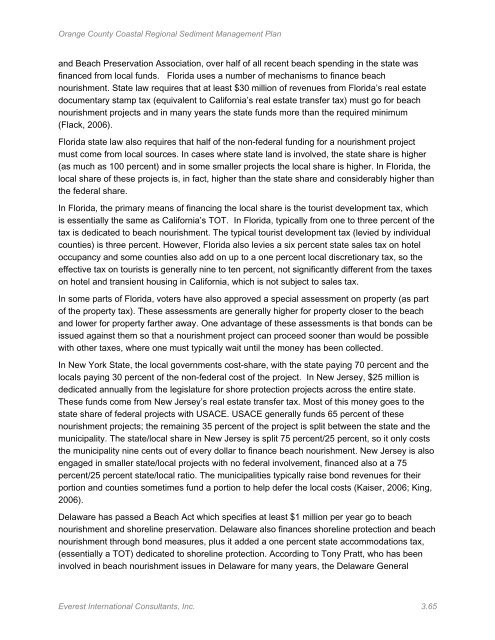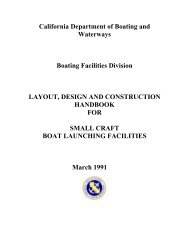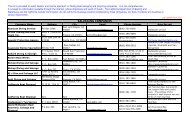EVEREST June, 2013 - California Department of Boating and ...
EVEREST June, 2013 - California Department of Boating and ...
EVEREST June, 2013 - California Department of Boating and ...
Create successful ePaper yourself
Turn your PDF publications into a flip-book with our unique Google optimized e-Paper software.
Orange County Coastal Regional Sediment Management Plan<br />
<strong>and</strong> Beach Preservation Association, over half <strong>of</strong> all recent beach spending in the state was<br />
financed from local funds. Florida uses a number <strong>of</strong> mechanisms to finance beach<br />
nourishment. State law requires that at least $30 million <strong>of</strong> revenues from Florida’s real estate<br />
documentary stamp tax (equivalent to <strong>California</strong>’s real estate transfer tax) must go for beach<br />
nourishment projects <strong>and</strong> in many years the state funds more than the required minimum<br />
(Flack, 2006).<br />
Florida state law also requires that half <strong>of</strong> the non-federal funding for a nourishment project<br />
must come from local sources. In cases where state l<strong>and</strong> is involved, the state share is higher<br />
(as much as 100 percent) <strong>and</strong> in some smaller projects the local share is higher. In Florida, the<br />
local share <strong>of</strong> these projects is, in fact, higher than the state share <strong>and</strong> considerably higher than<br />
the federal share.<br />
In Florida, the primary means <strong>of</strong> financing the local share is the tourist development tax, which<br />
is essentially the same as <strong>California</strong>’s TOT. In Florida, typically from one to three percent <strong>of</strong> the<br />
tax is dedicated to beach nourishment. The typical tourist development tax (levied by individual<br />
counties) is three percent. However, Florida also levies a six percent state sales tax on hotel<br />
occupancy <strong>and</strong> some counties also add on up to a one percent local discretionary tax, so the<br />
effective tax on tourists is generally nine to ten percent, not significantly different from the taxes<br />
on hotel <strong>and</strong> transient housing in <strong>California</strong>, which is not subject to sales tax.<br />
In some parts <strong>of</strong> Florida, voters have also approved a special assessment on property (as part<br />
<strong>of</strong> the property tax). These assessments are generally higher for property closer to the beach<br />
<strong>and</strong> lower for property farther away. One advantage <strong>of</strong> these assessments is that bonds can be<br />
issued against them so that a nourishment project can proceed sooner than would be possible<br />
with other taxes, where one must typically wait until the money has been collected.<br />
In New York State, the local governments cost-share, with the state paying 70 percent <strong>and</strong> the<br />
locals paying 30 percent <strong>of</strong> the non-federal cost <strong>of</strong> the project. In New Jersey, $25 million is<br />
dedicated annually from the legislature for shore protection projects across the entire state.<br />
These funds come from New Jersey’s real estate transfer tax. Most <strong>of</strong> this money goes to the<br />
state share <strong>of</strong> federal projects with USACE. USACE generally funds 65 percent <strong>of</strong> these<br />
nourishment projects; the remaining 35 percent <strong>of</strong> the project is split between the state <strong>and</strong> the<br />
municipality. The state/local share in New Jersey is split 75 percent/25 percent, so it only costs<br />
the municipality nine cents out <strong>of</strong> every dollar to finance beach nourishment. New Jersey is also<br />
engaged in smaller state/local projects with no federal involvement, financed also at a 75<br />
percent/25 percent state/local ratio. The municipalities typically raise bond revenues for their<br />
portion <strong>and</strong> counties sometimes fund a portion to help defer the local costs (Kaiser, 2006; King,<br />
2006).<br />
Delaware has passed a Beach Act which specifies at least $1 million per year go to beach<br />
nourishment <strong>and</strong> shoreline preservation. Delaware also finances shoreline protection <strong>and</strong> beach<br />
nourishment through bond measures, plus it added a one percent state accommodations tax,<br />
(essentially a TOT) dedicated to shoreline protection. According to Tony Pratt, who has been<br />
involved in beach nourishment issues in Delaware for many years, the Delaware General<br />
Everest International Consultants, Inc. 3.65




